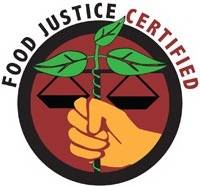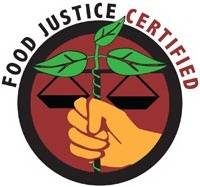Food Studies features the voices of 11 volunteer student bloggers from a variety of different food- and agriculture-related programs at universities around the world. You can explore the full series here.
 A new Food Justice label launched by the Agricultural Justice Project this summer seeks to offer consumers a guarantee of “fair pricing for the farmer and just working conditions for farm and food business workers.” When I first started working with school gardens, I was using the term “food justice” a lot.
A new Food Justice label launched by the Agricultural Justice Project this summer seeks to offer consumers a guarantee of “fair pricing for the farmer and just working conditions for farm and food business workers.” When I first started working with school gardens, I was using the term “food justice” a lot.
And I thought I knew what it meant.
And I did know what it meant — to an extent. I knew how to use the term “food justice” in context — for example, that I was a proponent of food justice — and I thought that meant I knew what it was. I also thought everyone else knew what the term “food justice” meant, and that we all thought it meant the same thing. What that thing was, though, I couldn’t have told you in a straightforward definition.
But then, inevitably, someone did ask me to define it. And that’s when I found out that food justice was one of those terms that’s easy to use in a sentence, but not so easy to explain.
My first instinct was to say that food justice meant the right to good food. But even as I heard the words coming out of my mouth, they felt wrong — fuzzy, imprecise. What did I mean by “good” food? (Nutritious? Tasty? Affordable?) Who was determining what “good” food was? (Me? The USDA? The New York Times dining section?) And, most importantly, what right did I have to cast a judgment — good or bad — on the way that people eat?
I could tell, after saying “good” food just a few times, that I had to do better. I am, after all, a writer. Every day, I tell my students (and myself) that our choice of words really matters, and that precision in language really matters.
A quick Google search led me to a number of definitions, all different and all compelling, demonstrating that part of the beauty of the term “food justice” is just how much it can encompass. Some organizations, such as Oxfam, focus their definitions of food justice on issues surrounding hunger, food security, and imbalances in the distribution of resources. Another definition, from the book Food Justice, states “Food justice seeks to ensure that the benefits and risks of where, what, and how food is grown, produced, transported, distributed, accessed and eaten are shared fairly. Food justice represents a transformation of the current food system, including but not limited to eliminating disparities and inequities.”
Finally, the definition that is closest to my own approach is from the organization Just Food, which defines food justice as “communities exercising their right to grow, sell and eat healthy food.” The definition continues, “Healthy food is fresh, nutritious, affordable, culturally-appropriate and grown locally with care for the well-being of the land, workers and animals. People practicing food justice leads to a strong local food system, self-reliant communities and a healthy environment.”
The writer/English teacher in me can’t help but do a little close reading of this incredibly well-constructed definition. Every single word here is perfect — the emphasis on communities and their rights as a group, as well as the inclusion of the entire process of food production (growing, selling, and eating). And then, of course, there’s the use of the word “healthy,” which comes with its own definition that approaches the idea of health from a holistic standpoint that includes but is not limited to nutrition.
What is most interesting to me, though, about this definition, are the terms “culturally-appropriate” and “self-reliant.” The sustainable food movement is often accused of being elitist, but these terms — “culturally-appropriate” and “self-reliant” — are democratizing and egalitarian. These are terms that guard against a kind of culinary imperialism, in which those with more power in our society impose their idea of “good” food on those with less.
Right now, I’m thinking a lot about how school gardens fit into the food justice movement, especially in terms of what it means to be culturally appropriate. So far, I have more questions than answers. But there’s one thing I know for sure: Language does matter, whether in writing fiction or writing about food. In the future, I won’t be classifying food choices as good or bad, at least not without further defining my terms.



